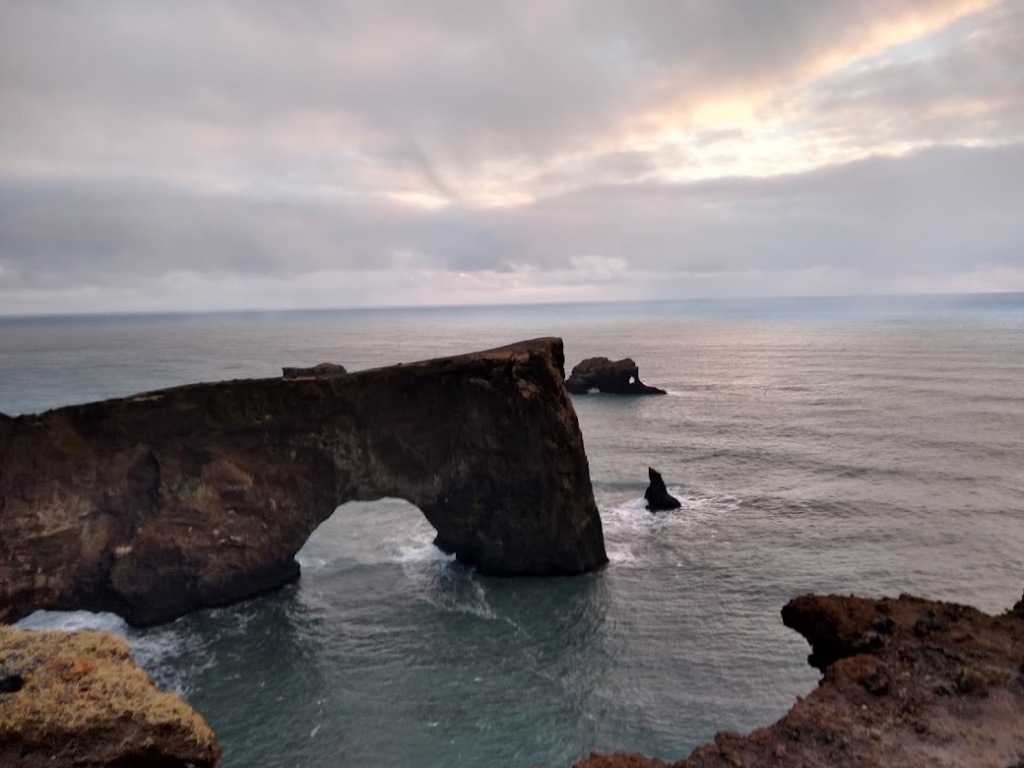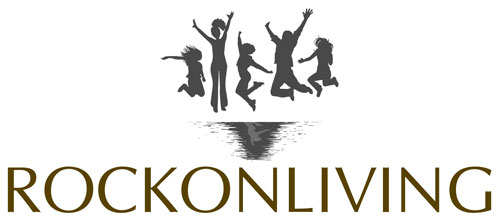
Iceland is about 18-25 millions year old. Sounds pretty impressive, right? So you may be surprised to hear it is actually one of the youngest countries in the world! Iceland lies where the Arctic Ocean and the North Atlantic Ocean meet. Iceland is sparsely inhabited, with the majority of its 300,000ish Icelanders concentrated mostly in the capital city Reykavik. Now would be an awesome time to Google or take a look at a map to orient yourself to the location of Iceland on our globe.
After a long day of travel and knowing we had an early rise today, I fell asleep quick and hard the night before. I woke up at some point during the evening and found myself in an almost drunk stupor of confusion over what in the world time it was! I looked at my Fitbit and it glowed 05:27. I figured I might as well get up and moving as I knew we were going to need to find some coffee (remember, day one post about the mysterious coffee machine we had not mastered at this point?) and get packed and organized for our 2 day overnight bus tour of Iceland’s Golden Circle. However, when I walked into the kitchen, the clock displayed 22:27. I was so utterly confused…what time was it? I Googled “what time is in Iceland?” And sure enough, it was only 22:27 (10:27pm)! I could go back to sleep? Like for a long time…so weird.
ROCKONLIVING TIP: In Iceland & Amsterdam AirBnB’s offer much more privacy, space & flexibility in meals – less eating out/less expensive. During Covid (Amsterdam was under a lock down during this trip) they also offer less exposure to others and a place to eat comfortably while not allowed to eat inside restaurants. Our experience has also found that most AirBbB’s have more flexible check in and check out times. Many AirBnB’s also give you the opportunity to get a better “taste” or “flair” of what it is like to live in the place you are visiting. Some of our favorite new friends we have made during our travels are the homeowners of these places as you usually have direct contact with them during your stay.
Quinn and I let the girls sleep a little longer and we headed out to secure some coffee and sauntered the empty streets. Quiet. Peaceful. The aroma of a fresh baked pastry filling the silence, and soon our tummies.

The Hallgrimskirkja, the tall church that overlooks the city, has the most amazing bells that greet the hour – like an echo-vibrational hug, only with sound. We would be meeting our tour bus next to this church at 8am. As we begin our exploration of Iceland today, I want you to really take a good look at the architecture of this sanctuary in the photos below at sunset and see if you can spot the inspiration the architect, Gudjon Samuelsson, incorporated into its design.

After rounding up the girls, packing our overnight bags, we walked over to the Hallgrimskirkja at our meeting point for our tour bus pick-up. It was so surreal to be 8am and pitch dark. The city going about its business with headlights on and it would remain this way until about 11am. Our tour was very mindful of the 4 to 5 hours of daylight and as we explored the the Golden Circle. Taking a tour allowed for all five of us to really relax, listen, and take in the scenery of Iceland. Due to the number of Icelandic features we wanted to see, possible unpredictable weather at times and limited hours of sunshine, we were very grateful to have explored the Golden Circle with a tour guide.
On this trip, Covid was like a bass note, always there, beating away, not the melody of the trip, but providing the constant rhythm to the trip. Our tour company was extremely mindful of keeping everyone safe. There were around 25 of us on the bus and masks were worn at all times inside. When we stopped at our overnight destination we were split into two groups for dinner to ensure adequate social distancing during our meal when masks would be removed.
As we got on our bus and ready for our adventure our tour guide kicked off our meet and greet asking “did anyone felt the earthquake last night?” (maybe that is why I woke up so oddly??) Evidently while we were sleeping an earthquake shook Reykjavik and measured a 4.3 on the Richter Scale. He shared this was a consequence of a major shift underground of magma flow, so incredible! He then went on to share that there were over 1500 after shocks following the initial shake! Man, how I wish I had been awake to experience that.
Our first day consisted of driving South and then West from Reykjavik. This drive gave us a nice opportunity to sit back and really observe the small towns scattered between the capital and Vik. We were able to see quaint little villages with Christmas decorations, snow capped mountains, wide open plains and oh my word, waterfalls and outlet glaciers. We listened to the tour guide share their Viking history and facts about the culture, story and geothermal features of his beloved country.
Many times we commented on how the surface of Iceland looks just like images of the moon or mars. I believe I read that Iceland resembles the moon so much, that one of Iceland’s calderas were used for training for landing on moon! There are over 130 volcanoes! We passed several geothermal power plants and glowing massive greenhouses that attempt to produce produce for the island year round – strawberries, avocados, tomatoes, even bananas. Food is expensive in Iceland and they are trying to find ways to produce their own supply.
Below is a collection of images of various waterfalls and glacier outlets (a valley glacier that drains from an ice cap) we enjoyed on our first day.













We also went out on a huge plateaued mountaintop that had a lonely lighthouse to gaze out on the raging rough ocean below on boulders and rocks. Absolutely stunning. On this trip our tour guide was only super serious twice. It was always surrounding our safety – mostly in relationship to wind and waves. Like I said, the wind never gave us a problem on this trip, but during our walk to the Dyroholaey Lighthouse (built in 1910 and marks the southernmost point of mainland Iceland) we were gravely cautioned to absolutely stay behind the ropes on the walkways as rogue winds would and have gusted and suddenly taken a person posing for a risky selfie over the boulder and down into the fierce water below. Like the National Parks in the USA, there are no rangers or police keeping tourists in check, so heed the warnings. People die. On vacation. In front of their families and friends. Don’t be that guy.
This Lighthouse area allows amazing views of a treacherous surf and cliffs and magnificently shaped boulders in the water. You can also see one of the black sand beaches below. This was probably one of the coldest windiest experiences of our trip! We were all thankful for our windproof jackets! A sampling of our photos are below.













The final place we visited before settling into our hotel for the evening was Reynifjara Beach (one of the top ten NONtropical beaches in the world), a cool black sand beach located next to the small fishing village of Vik. This beach is stunning and dangerous. It is famous for it’s cool french fry rocks or Lego looking rock formations/caves.
FUN FACT: Reynisfjara may look familiar to some of you as it has been the setting/backdrop for some major TV and movie pictures (Game of Thrones and one of the Star War movies).
These french fry rocks are the geological result of a prior volcano that erupted and then very slowly, like very very slowly cooled over time causing the basalt lava to cool and contract. These rock formations are called basalt columns and are rich in iron and magnesium. During the cooling process hexagonal columns form through a process called “columnar jointing.” The basaltic lava flows and cools slowly over time, it shrinks in volume and cracks into symmetrical patterns. They form because of how the lava cools. The process begins at different spots called “centers” and if the centers are evenly spaced out, the forces that pull inward toward the centers end up creating the columns of cooling lava from the sides to form into these hexagonal shapes.
Want to hear more about this process? Check out the Youtube video entitled “Columnar Basalt 2 minute geology video.” Not only does it have a catchy acoustic “2 minute geology” song and is narrated by an enthusiastic scientist donning a red bow tie and all, but he quickly describes the geological explanation for these very cool rocks. He also shares that many of these rock formations were created under the ground over 10 million years ago, took over a century to “cool” and only appeared on the surface of earth after the last ice age when the glaciers retreated to the poles and took so much land with them they uncovered some of the columns in the process! Say what?
Basalt, which is an extrusive igneous (volcanic) rock that is low in silica, dark and comparatively rich in iron and magnesium. I knew we had seen this type of rock before and after some investigation we recalled it was the rock we climbed in the middle of Wyoming, DEVILS TOWER! Nature, we are learning, is such a repetition of patterns, mathematical…such structure and order from even the most powerful chaotic phenomenons, even a volcanic eruption!











Why black “sand”? It is the result of volcanic rock that has been worn away not quite into the fine grain/sand you may think of on a beach, but tiny pebbles. DO NOT SWIM IN THE WATER, get too close to the water’s edge or turn your back on the ocean. This beach is notorious for “Sneaker Waves,” waves that suddenly create and break at shore line. We witnessed many. They are huge and loud and are no joke. Like we shared earlier, our tour guide was funny and easy going, but never about safety. The beaches and waves were his second non-negotiable on this trip. Unfortunately, this black sand beach and at diamond beach tourists have lost their lives not listening or reading the signs of warning. Be smart.
NOT A FUN FACT: Deforestation in Iceland is very evident. The country is in the process of replanting and recovering many of their forests that were cut down when Iceland was being settled and built ages ago.
It was now getting dark as the sun was beginning to set (4pm!) so we stopped for a quick cup of something warm, took some cool pictures of a quaint little church and the town of Vik and headed to our hotel for dinner and some sleep before an early rise to go hiking and exploring ice caves in one of Iceland’s biggest glaciers!










Ok, so back to the magnificent church in Reykavik. Did you spot two of the geological features of Iceland the architect infused into his design?



See you tomorrow!
Until then, RockonLIVING friends!


I want to to thank you for this good read!! I certainly loved every little bit of it. I have you bookmarked to look at new things you postÖ
You have remarked very interesting points!
ps decent site.Blog monry